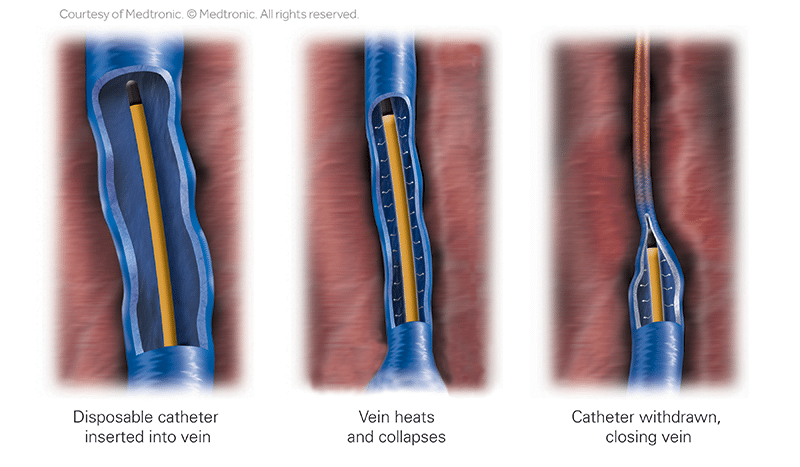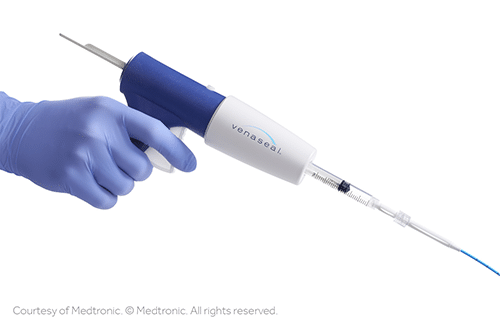Venous Ablations
Ablation means a doctor uses heat to damage abnormal tissue in the body, which then makes scar tissue form. Venous ablations are used to treat Chronic Venous Insufficiency (CVI) and varicose veins.
Chronic venous insufficiency (CVI) is a progressive medical condition that may worsen over time and affects the veins and vessels in the leg that carry blood back toward the heart.
The veins in your legs carry blood back to your lungs & heart. The veins have one-way valves that keep blood from flowing backward.
If you have chronic venous insufficiency (CVI), the malfunctioning (incompetent) valves don’t work like they should and some of the blood may go back down into your legs. This causes blood to pool or collect in the veins of the lower legs. This condition is called Venous Reflux.
Over time, CVI can cause pain, swelling, and skin changes in your legs. It may also lead to open sores, called ulcers, on your legs.
The signs and symptoms of CVI may include pain, swelling and fatigue of the legs, as well as skin damage and ulcers. CVI is often leads to bulging varicose veins.
- Visual varicose veins
- Aching or pain
- Swelling (edema) – especially at the end of the day
- Cramping
- Heaviness or tiredness
- Itching
- Restlessness
- Skin changes
- Brown, colored skin
- Open sores or ulcers
The risk factors for chronic vein insufficiency include:
- Family history (heredity)
- Multiple child births
- Lack of exercise
- Prolonged sitting or standing
- Obesity or excess weight
- Current or previous pregnancies
- Smoking
- Over age 50
- Leg injury or trauma
Venous Ablation Procedures at San Tan Cardiovascular Center
San Tan Cardiovascular Center offers the Medtronic ClosureFast™ ablation procedure, the Medtronic VenaSeal™ ablation procedure, and Sclerotherapy.
Both ablation procedures essentially take the place of “vein stripping”. They are performed in our beautiful Gold Canyon office, offering you a comfortable and convenient experience.
Medtronic ClosureFast™ Venous Radiofrequency Ablation (RFA)
In Radiofrequency Ablation (RFA), the doctor inserts a small catheter into the problem vein through a small IV in the lower leg, using ultrasound guidance for an accurate and live view. Consistent and uniform heat is delivered to irritate the vein walls, causing them to collapse and close. After the vein is closed, the blood flow is diverted to nearby veins that are healthy and working properly, bringing blood back to the heart.

This is a minimally invasive treatment for varicose veins or chronic venous insufficiency (CVI).
This technique uses radiofrequency energy to heat up and damage the wall inside a vein, resulting in the closure of a varicose vein in the leg.
To treat a varicose vein, radiofrequency energy is directed through a thin tube (catheter) inserted through a small IV placed in the vein of the lower leg. This procedure is done using a local anesthesia and/or a mild sedative.
The area will be cleaned, sterilized and the area covered with a surgical drape.
Your doctor will numb the area with a local anesthetic where the sheath (IV) enters the problem vein. The doctor and ultrasound sonographer will use an ultrasound probe to study the vein and track its path up the leg.
Using ultrasound to visualize the vein, the doctor inserts the ablation catheter through the sheath and positions it within the abnormal vein. Once the catheter is in the correct placement, a local anesthetic numbing solution is injected along the path of the catheter.
After numbing is complete, the catheter delivers radiofrequency heat to the vein wall, causing it to shrink and the vein to seal closed.
After the ablation is complete, the sheath is removed from the leg and pressure is applied to prevent any bleeding. If bleeding does occur, it should be minimal since the vein is closed and the remaining blood is just “leftovers”. A bandage is applied to the skin along with a temporary compression stocking.
This procedure is usually complete within an hour. You will be able to walk following the treatment and recovery is typically short.
After treatment, you will wear compression stockings for 2 weeks and be scheduled for a follow up ultrasound within 72 hours to check for blood clots. In 2 months, you will have an ultrasound of your legs and visit with the physician to discuss how well your veins are doing.
Medtronic VenaSeal™ Venous Ablation (Glue)
This procedure uses a medical adhesive glue to close the problem vein instead of using heat.
Using ultrasound guidance for an accurate and live view, the doctor inserts a small catheter into the problem vein through a small IV in the lower leg. The glue is injected and pressure is applied to close the vein. This is done in 3 inch segments along the path of the vein. After the vein is closed, the blood flow is diverted to nearby veins that are healthy and working properly, bringing blood back to the heart.

Venaseal™ is a minimally invasive treatment for varicose veins or chronic venous insufficiency (CVI). This technique uses a medical grade adhesive to shut down and close the wall inside a vein, resulting in the closure of a problem vein in the leg.
To treat a varicose vein, a medical grade adhesive is directed through a thin tube (catheter) inserted through a small IV placed in the vein of the lower leg. This procedure is done using a local anesthesia and/or a mild sedative.
The area will be cleaned, sterilized and the area covered with a surgical drape.
Your doctor will numb the area with a local anesthetic where the sheath (an IV) enters the problem vein. The doctor and ultrasound sonographer will use an ultrasound probe to study the vein and track its path up the leg.
Using ultrasound to visualize the vein, the doctor inserts the catheter through the sheath and positions it within the abnormal vein.
Once the catheter is in the correct placement, the adhesive is injected in segments along the entire course of the vein. This closes down the vein completely and is confirmed with ultrasound.
After the ablation is complete, the sheath is removed from the leg and pressure is applied to prevent any bleeding. If bleeding does occur, it should be minimal since the vein is closed and the remaining blood is just “leftovers”. A bandage is applied to the skin.
This procedure is usually complete within an hour. You will be able to walk following the treatment and recovery is typically short.
One of the benefits of the VenaSeal™ procedure is that you are not required to wear compression stockings after treatment. In 2 months, you will have an ultrasound of your legs and visit with the physician to discuss how well your veins are doing.
Sclerotherapy
Sclerotherapy is a treatment option for painful spider veins and small or “bendy” varicose veins where the catheter can’t be used.
It involves injecting a solution, or a foam solution, into the vein that irritates the inside of the vein, causing it to shut down and close off. Sometimes multiple sclerotherapy sessions are needed, depending on the extent and amount of the problem veins.
How do I get started?
Contact San Tan Cardiovascular Center today to make an appointment with one of our healthcare providers.
At this appointment:
- we will review your medical history, discuss your symptoms and perform a non-invasive, diagnostic test to further determine your medical condition,
- any pertinent testing that needs to be done beforehand will also be ordered at this time.
Our billing department will then contact your health insurance company to obtain prior authorization. Upon receiving insurance authorization, the procedure will be scheduled.
Venous Ablation FAQs
Q: Why is a Venous Ablation performed?
A: Venous ablation is performed to shut down the veins that have malfunctioning (incompetent) valves that are causing the blood to pool (reflux) in the legs. By shutting down the veins that are not working properly, the blood is diverted to the other nearby veins that are normal.
Q: Is it dangerous to close my veins?
A: It is not dangerous to close or shut down the veins that aren’t working properly! In fact, it is more dangerous to leave these veins alone. Usually if left untreated, they can lead to bulging varicose veins, pain and worse blood clots. The blood clots in the veins are called deep vein thrombosis – DVT.
These blood clots in the legs can travel to the lungs and block a blood vessel. This condition is called a pulmonary embolism (PE). This causes low oxygen levels in your blood. Pulmonary embolisms can damage the lung and other organs and cause heart attack and heart failure.
Q: If you shut down the vein, where will the blood go?
A: By shutting down the vein that is not functioning properly, the blood will be diverted/rerouted naturally to the other veins in your legs.
Q: Does my insurance cover these procedures?
A: Most insurances cover these minimally invasive procedure. Our billing office will get prior authorization from your insurance company before we proceed.